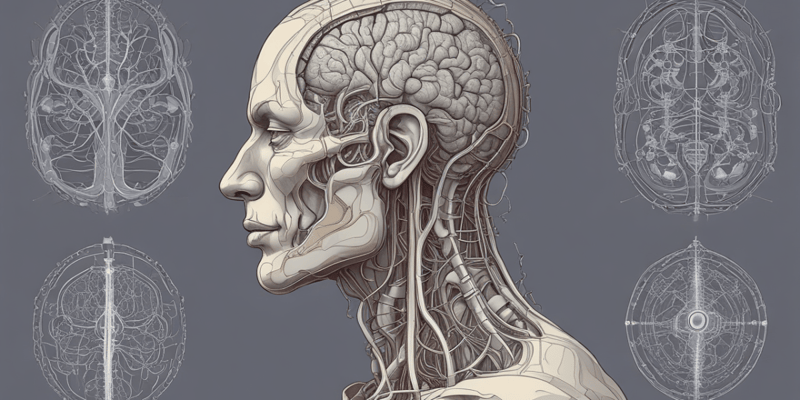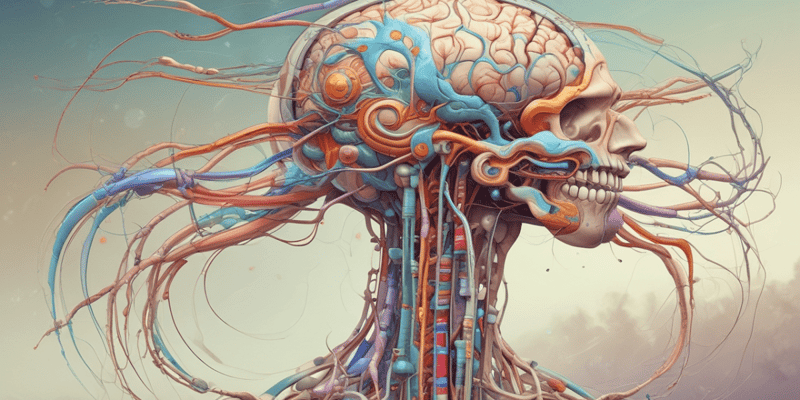5 Questions
Describe the difference between mechanoreceptors and nociceptors in terms of their response to pressure and pain stimuli.
Mechanoreceptors respond to pressure and touch stimuli, whereas nociceptors respond to painful stimuli. Mechanoreceptors are involved in proprioception and sensing touch, pressure, and vibration, while nociceptors detect and respond to painful stimuli, such as heat, cold, and chemical irritants.
Compare and contrast the functions of the sympathetic and parasympathetic nervous systems, highlighting their respective neurotransmitters and receptors.
The sympathetic nervous system (SNS) is responsible for the 'fight or flight' response, stimulating the release of norepinephrine (NE) and epinephrine (E) from sympathetic neurons, which bind to alpha- and beta-adrenergic receptors. In contrast, the parasympathetic nervous system (PNS) promotes relaxation and rest, releasing acetylcholine (ACh) from parasympathetic neurons, which binds to muscarinic and nicotinic receptors.
Identify the cranial nerves responsible for transmitting sensory information related to taste, hearing, and balance.
Cranial nerves VII (facial nerve), VIII (vestibulocochlear nerve), and IX (glossopharyngeal nerve) are responsible for transmitting sensory information related to taste, hearing, and balance.
Describe the organization and function of the brachial plexus, including the major nerves that arise from it and their distribution.
The brachial plexus is a complex network of nerves that arises from the ventral rami of cervical spinal nerves C5-T1. It gives rise to major nerves, including the radial, median, and ulnar nerves, which distribute to the arm, forearm, and hand, providing motor and sensory innervation.
Compare and contrast the sensory receptors responsible for detecting chemical stimuli, including olfactory and taste receptors.
Olfactory receptors are specialized receptors in the nasal mucosa that detect odor molecules, whereas taste receptors are present on the tongue and detect chemical stimuli related to sweet, sour, salty, bitter, and umami tastes. Both types of receptors are chemosensors that respond to specific chemical stimuli, but they differ in their structure, function, and distribution.
Study Notes
Sensory Processing
- Sensory receptors respond to various stimuli, including pain, temperature, pressure, touch, and chemical stimuli.
- Reflexes involve automatic responses to stimuli, often involving the spinal cord and brain.
Cranial Nerves
- There are 12 cranial nerves, each with distinct functions and pathways.
- The cranial nerves are:
- Olfactory nerve (I)
- Optic nerve (II)
- Oculomotor nerve (III)
- Trochlear nerve (IV)
- Trigeminal nerve (V)
- Abducens nerve (VI)
- Facial nerve (VII)
- Vestibulocochlear nerve (VIII)
- Glossopharyngeal nerve (IX)
- Vagus nerve (X)
- Spinal accessory nerve (XI)
- Hypoglossal nerve (XII)
Nerve Plexuses
-
Cervical plexus: formed by C1-C4 spinal nerves, supplies the neck and shoulder region.
- Major nerves arising from the cervical plexus:
- Lesser occipital nerve
- Greater occipital nerve
- Transverse cervical nerve
- Major nerves arising from the cervical plexus:
-
Brachial plexus: formed by C5-T1 spinal nerves, supplies the arm and hand.
- Major nerves arising from the brachial plexus:
- Radial nerve
- Median nerve
- Ulnar nerve
- Major nerves arising from the brachial plexus:
-
Lumbar plexus: formed by L1-L4 spinal nerves, supplies the lower back and leg.
- Major nerves arising from the lumbar plexus:
- Femoral nerve
- Obturator nerve
- Major nerves arising from the lumbar plexus:
-
Sacral plexus: formed by L4-S4 spinal nerves, supplies the pelvis and leg.
- Major nerves arising from the sacral plexus:
- Sciatic nerve
- Tibial nerve
- Common peroneal nerve
- Major nerves arising from the sacral plexus:
Autonomic Nervous System
-
Parasympathetic nervous system:
- Originates in the brain stem and sacral region
- Uses acetylcholine as a neurotransmitter
- Receptors: M1, M2, M3, and Nm
- Physiological effects: promotes relaxation, reduces heart rate, and increases digestion
-
Sympathetic nervous system:
- Originates in the thoracic and lumbar regions
- Uses norepinephrine as a neurotransmitter
- Receptors: α1, α2, β1, and β2
- Physiological effects: prepares the body for "fight or flight," increases heart rate and blood pressure
This quiz covers sensory processing, cranial nerves, nerve plexuses, and the autonomic nervous system, including the parasympathetic and sympathetic systems.
Make Your Own Quizzes and Flashcards
Convert your notes into interactive study material.
Get started for free



